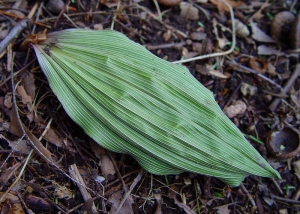You may have to stretch your imagination a bit to embrace the common name of this exciting West Virginia resident. That plant, Tipularia discolor, is a terrestrial orchid closely related to Aplectrum hyemale, aka “Adam & Eve,” aka “Putty Root.” Its common name is “Crane Fly Orchid,” as the blossoms resemble a Crane Fly lighting on the wiry flower stem.
Although there seem to be almost as many dissimilarities as similarities between the two plants, both Tipularia discolor and Aplectrum hyemale have the same bloom cycles, producing a single leaf in the fall. That leaf persists all winter long, no matter how brutal the weather, and then senesces (a fancy word for a dead leaf) in the spring.
Tipularia is a bit shyer about flowering than the Aplectrum, and both species are in monotypic genera, meaning they are the only species in their respective genera. Tipularia favors much richer soil with lots of decaying tree matter, while Aplectrum seems to pop up just about anywhere and in larger colonies.
Both plants produce a new tuber yearly while the old one eventually withers away. There’s plenty of time to pull the previous year’s tuber off and replant it before it shrivels, and that’s the easiest way to propagate these plants as the dust-like seeds, while produced in tremendous quantity, have very particular needs to germinate and, if germinated, take years to mature.
Tipularia requires very particular moths to capture and transfer the pollen. These little critters must be tempted to go deep into the flower to get to the pollen and eventually carry it out of the flower on their eyes onto the next flower they visit. Fascinating!
As far as Tipularia’s name goes, it appears that Linnaeus borrowed it from the insect world, and this is one of those rare instances where the common name and the scientific name are allied. The genus that the Crane Fly belongs to just happens to be Tipula! The specific epithet (the second word in a scientific plant name), "discolor," refers to the spotting on the leaf which I find very attractive. If you take a peek on the underside of the leaf, you’ll discover that it’s a lovely deep, rich purple color.
So keep your eyes peeled while on your winter woodland hikes and perhaps you’ll be fortunate enough to stumble onto a colony of these diminutive treasures.
Single-leafed orchid grows wild in West Virginia woodlands

This here story is a tale about a very interesting native plant that just happens to be one of the many species of orchids that grow wild in our lush mountains and valleys. Some may find it hard to believe that orchids grow in West Virginia, but it's no fantasy. More than 20 species grow right here. One of the most interesting may be "Putty Root" and "Adam-&-Eve" also known as Aplectrum hyemale. Read the full story here.
Visit and shop Sunshine Farm & Gardens near Lewisburg, West Virginia, for more native plant information, and be sure to sign up for their newsletter.
Sign up to receive a FREE copy of West Virginia Explorer Magazine in your email weekly. Sign me up!



